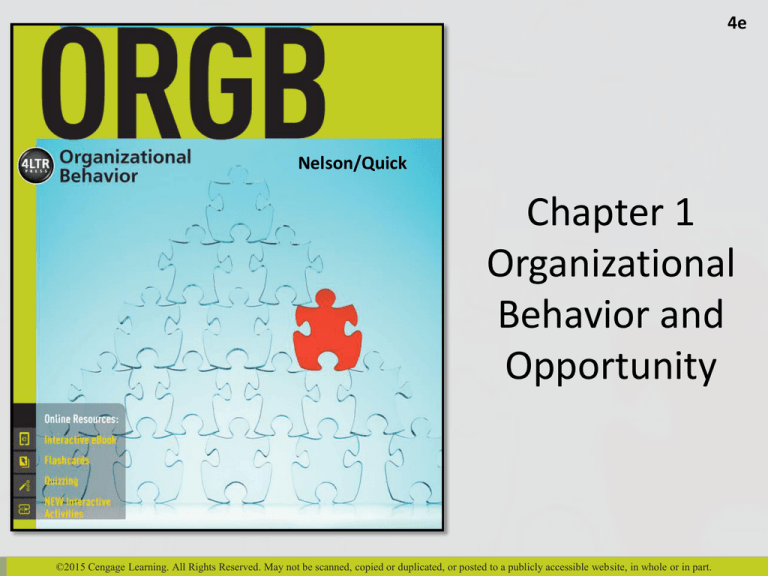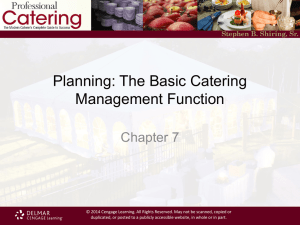
4e
Nelson/Quick
Chapter 1
Organizational
Behavior and
Opportunity
©2015 Cengage Learning. All Rights Reserved. May not be scanned, copied or duplicated, or posted to a publicly accessible website, in whole or in part.
Learning Outcome
Define organizational behavior
Identify four action steps for responding positively
in times of change
Identify the important system components of an
organization
Describe the formal and informal elements of an
organization
©2015 Cengage Learning. All Rights Reserved. May not be scanned, copied or duplicated, or posted to a publicly accessible website, in whole or in part.
2
Learning Outcome
Identify factors that contribute to the diversity of
organizations in the economy
Describe the opportunities that change creates for
organizational behavior
Demonstrate the value of objective knowledge and
skill development in the study of organizational
behavior
©2015 Cengage Learning. All Rights Reserved. May not be scanned, copied or duplicated, or posted to a publicly accessible website, in whole or in part.
3
Organizational Behavior
Study of individual behavior and group
dynamics in organizations
©2015 Cengage Learning. All Rights Reserved. May not be scanned, copied or duplicated, or posted to a publicly accessible website, in whole or in part.
4
Organizational Behavior: Dynamics in
Organizations
Psychosocial
Organizational
Behavior
Behavioral
Interpersonal
©2015 Cengage Learning. All Rights Reserved. May not be scanned, copied or duplicated, or posted to a publicly accessible website, in whole or in part.
5
Organizational Variables that
Affect Human Behavior
Jobs
Work Design
Communication
Performance
appraisal
Organizational
design
Organizational
structure
©2015 Cengage Learning. All Rights Reserved. May not be scanned, copied or duplicated, or posted to a publicly accessible website, in whole or in part.
6
Interdisciplinary Influences on
Organizational Behavior
Psychology
Sociology
Engineering
• Science of human
behavior
• Science of society
• Applied science of
energy and matter
Anthropology
Management
Medicine
• Science of human
learned behavior
• Overseeing
activities and
supervising people
• Applied science of
healing or treating
diseases
©2015 Cengage Learning. All Rights Reserved. May not be scanned, copied or duplicated, or posted to a publicly accessible website, in whole or in part.
7
Reactions to Change
Rigid and
Reactive
Open and
Responsive
©2015 Cengage Learning. All Rights Reserved. May not be scanned, copied or duplicated, or posted to a publicly accessible website, in whole or in part.
8
Components of an Organization
Task
• Organization’s mission, purpose, or goal for existing
People
• Human resources of the organization
Technology
• Tools, knowledge, and/or techniques used to transform inputs into
outputs
Structure
• Tools, knowledge, and/or techniques used to transform inputs into
outputs
©2015 Cengage Learning. All Rights Reserved. May not be scanned, copied or duplicated, or posted to a publicly accessible website, in whole or in part.
9
Formal vs. Informal Organization
Formal organization: Official, legitimate, and most
visible part of the system
Informal organization: Unofficial and less visible
part of the system
Hawthorne studies: Studies conducted during the
1920s and 1930s that suggested the importance of
the informal organization
©2015 Cengage Learning. All Rights Reserved. May not be scanned, copied or duplicated, or posted to a publicly accessible website, in whole or in part.
10
Sectors of the U.S. Economy
Private sector
Nonprofit
sector
Large and
small
organizations
Government
sector
Manufacturing
sector
Service sector
©2015 Cengage Learning. All Rights Reserved. May not be scanned, copied or duplicated, or posted to a publicly accessible website, in whole or in part.
11
Global Competition in Business
Increased Global Competition
Radical Change
©2015 Cengage Learning. All Rights Reserved. May not be scanned, copied or duplicated, or posted to a publicly accessible website, in whole or in part.
12
Three Key Questions in Evaluating
Quality-Improvement Ideas
Does the idea improve customer response?
Does the idea accelerate results?
Does the idea raise the effectiveness of
resources?
©2015 Cengage Learning. All Rights Reserved. May not be scanned, copied or duplicated, or posted to a publicly accessible website, in whole or in part.
13
Challenges to Managing
Organizational Behavior
Increasing globalization of organizations’ operating
territory
Increasing diversity of organizational workforces
Continuing technological innovation with its
companion need for skill enhancement
Continuing demand for higher levels of moral and
ethical behavior at work
©2015 Cengage Learning. All Rights Reserved. May not be scanned, copied or duplicated, or posted to a publicly accessible website, in whole or in part.
14
Figure 1.3 - Learning about
Organizational Behavior
©2015 Cengage Learning. All Rights Reserved. May not be scanned, copied or duplicated, or posted to a publicly accessible website, in whole or in part.
15
Figure 1.4 - Learning from Structured
Activity
©2015 Cengage Learning. All Rights Reserved. May not be scanned, copied or duplicated, or posted to a publicly accessible website, in whole or in part.
16
Application of Knowledge and Skills
Structured, experiential learning helps explore new
behaviors and skills in a comparatively safe
environment
Educates students rather than training them in
organizational behavior
Students become coproducers in learning
©2015 Cengage Learning. All Rights Reserved. May not be scanned, copied or duplicated, or posted to a publicly accessible website, in whole or in part.
17








